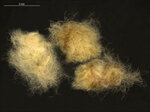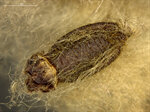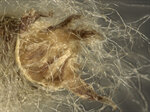Taxonomy
Arctotheca calendula (L.) Levyns, J. S. African Bot. viii. 284 (1942).Common synonyms
Arctotis calendula L., Sp. Pl. 2: 922. 1753.Common name
Capeweed
Description
Fertile part of fruit 2-2.5 mm long, 1-1.5 mm wide, in side view widest in upper part (obovoid) or widest in the middle, +/- straight, the upper (apical) end narrowing, in cross-section flattened, basal scar (carpopodium) central, beak (=thinner sterile stalk between seed and pappus) absent, wings absent, fruit surface light brown or straw or dark brown, with transversal wrinkles, with very dense woolly / crispate hairs, thickened margin present, thick margin hairs no hairs (glabrous) or woolly / crispy hairs, longitudinal ribs absent, wilted flower mostly absent.
Pappus type scales, pappus elements all +/- similar, up to 0.5-1 mm long, in one row, number of pappus elements c. four to eight, pappus position central on upper end of fruit, persistent, the individual scales triangular to acute or dissected.
Notes: Pappus scales are fairly irregular and can be of varying sizes, but they have been scored here as not being differentiated into different types.
Ecology
Rosette herb. Mediterranean climates, somewhat dry to mesic environments, open areas such as low grassland or disturbed vegetation. Found especially in coastal, disturbed and urban areas.
Native range
South Africa.
Introduced range
United States (California), Argentina, Chile, United Kingdom, Portugal, Spain, France, Italy, Morocco, Tunisia, Australia, New Zealand. Transiently in other European countries.


